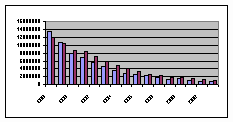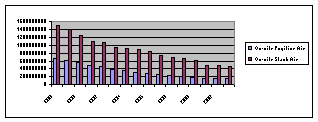Connecticut's Management of Toxic Air Pollutants
Air Toxics Air Pollution Trends
The Department program evaluates its success and progress by analyzing air quality and emission trends over a period of time, ideally, ten or more years. One of the Department's most important tasks is to monitor air quality and material deposited from the air. Air quality and emission data are used to study and determine the need for new pollution controls. Ambient air quality data is collected by measuring the actual concentration of pollutants in outdoor air. Emissions data are best available engineering calculations of the quantity of a pollutant emitted during a year or season from a specific source. The actual monitored data and emissions inventory data are tracked over time to identify significant changes.
Two existing publications which report on emission trends are EPA's Toxic Release Inventory and the Department's Air Emission Inventory. EPA's Toxic Release Inventory is a mandated program designed to provide public access to information on air, water and waste releases by facilities. This information is generated from annual reports to EPA from facilities. The Department's Air Emission Inventory is a compilation of emission estimates currently done on a three-year cycle to support planning efforts for the attainment of air quality standards.
Toxics Release Inventory Reductions:
The federal Emergency Planning and Community Right-to-know Act created the Toxics Release Inventory (TRI), on which EPA bases many studies. TRI was established following the 1984 release of toxic gas in Bhopal, India that resulted in many fatalities. This program serves to encourage companies to manage chemical hazards since required reporting data on chemical releases are made public. TRI is a national program and is independent of Connecticut’s point source inventory. Information on this program can be obtained at www.epa.gov/tri.
The EPA’s TRI annually tracks 650 toxic chemicals that are released to the air, water and land, or sent to other facilities for treatment. This inventory is the basis for many of EPA’s HAPs studies and policy development. Reductions in TRI releases to the air from 1988 to 2003 have been drastic despite of broadening of the list of reportable chemicals and inclusion of more industrial source categories.
In 2003, TRI reported the top ten emitters in Connecticut released 522,424 pounds of fugitive air emissions toxic substances. These ten sources, representing less than 7% of the 156 facilities which reported fugitive emissions that year, emitted 58% of the reported fugitive air emissions. The percentages are nearly identical for the Connecticut facilities reporting TRI stack releases.
Review of the TRI of the top ten chemicals released in Connecticut in 2003 showed that 85% of the total weight of reported fugitive emissions was attributable to ten substances. The top ten substances released from Connecticut stacks in 2003 accounted for 79% of the total weight of the 89 different substances reported released by TRI. Six chemicals, toluene, methanol, dichloromethane, trichloroethylene, methyl ethyl ketone and ammonia, appear in the top ten of both fugitive and stack emissions.
Though the list of TRI chemicals and the sources required to report their emissions have changed over the years, certain chemicals have remained on the list since 1988 and have been reported from sources throughout that time. These "1988 Core Chemicals" can be used as a guide to overall progress in emissions reductions.
Connecticut and National Trend in On-Site Fugitive and Stack Emissions for the 1988 Core Chemicals in pounds per year for 1988 - 2003.
Connecticut |
National |
In Connecticut, over the reporting period of 1988 to 2003 emissions of both fugitive and stack emissions have dropped from just under 14 million pounds per year to closer to 0.7 million pounds per year, or 5% of the original emissions. Since there was some suggestion that an early over reporting of emissions may have occurred, a comparison of 1990 to 2003 emissions was also made and showed that in Connecticut, the 2003 emissions were 10% of the 1990 value. Stack emissions are typically on par with fugitive emissions. However, national emissions show a more pronounced difference between fugitive and stack emissions, with stack emissions two to three times higher than fugitive emissions.
The 1988 Core Chemicals are considered most appropriate for trends analysis because they are least changed over the years. Over the reporting period of 1988 to 2003, Connecticut's fugitive emissions ended at five percent of their initial value while stack emissions ended the trend at ten percent of the initial value. Nationally, fugitive emissions end the trend at 22 percent of the original value, while stack emissions end at 30 percent of the original value. Overall, Connecticut has had greater reductions in reportable emissions than the nation as a whole.
While a valuable tool, the TRI data alone provides an insufficient basis for prioritizing a HAPs control strategy. TRI data must be viewed cautiously as it does not include reporting for all sources in Connecticut or for all emissions of HAPs. Although helpful, assessment of the health benefits attributed to HAPs reductions cannot be accurately calculated through exclusive use of chemical weight reductions, due to differences in potency and risk.
Connecticut Inventory
Connecticut presently has an inventory of air emissions of particulate matter with an aerodynamic diameter of less than 10 microns (PM10) and VOCs from point sources (i.e. larger or permitted sources which emit through a stack). PM10 and particulate matter with an aerodynamic diameter of less than or equal to 2.5 microns (PM2.5) are both components of the general category of particulate matter (PM). Historically, Connecticut’s inventory reported total particulates, but now reports PM10 specifically. This inventory is called the criteria pollutant inventory. Many HAPs, although not individually tracked in this inventory, are components of either PM or VOCs. Inventories of PM and VOCs, together with source category specific emission factors developed from emissions testing and process activity data, have been used by EPA to develop inventories for their studies of HAPs. EPA also uses emission factors to develop HAPs emission inventories of mobile and area sources, in addition to the inventories for point stationary sources. The mobile sector includes automobiles, off-road vehicles, certain construction equipment, trains, boats and other transportation sector sources. The area source category includes smaller point sources and consumer related emissions from activities such as outdoor grilling, dry cleaning, fast food restaurants, beauty salons, pesticide application, printing, degreasing and small boilers, among others. Since many of these sources also emit HAPs, the existing inventories can provide a understanding of the sources of HAPs emissions in the state and how they have changed over the years, even though Connecticut has not specifically tracked HAPs through the inventory process.
A review of Connecticut's point source inventory for the years 1990 and 1999, the most recent year available, showed nearly an 80 percent decrease in emissions of VOCs and about a 40 percent decrease for PM. These data are presented in the table below. This inventory for 2002, although not yet quality assured, shows further decreases in emissions of both VOCs and PM10. The more dramatic emissions reductions in VOCs may be the result of the focus on compliance with the ozone standard. Connecticut’s major air management focus has been compliance with the ozone standard, concentrating on reductions of VOC emissions. Only more recently has attention turned to a comparable statewide focus on emissions reductions for particulate matter. Moreover, the smaller decrease in PM emissions may reflect increased permitting of emergency engines during that time period, which resulted in shifting emergency engine PM emissions from the area sources category to the point source category.
|
Total actual Particulate Matter (PM) and Volatile Organic Compounds (VOCs) emissions from Connecticut DEEP's point source inventory 1990 and 1999. | ||||||
|---|---|---|---|---|---|---|
| Year | Number of Units | Number of Units with Permits | Reported Actual Tons of VOCs Emissions from All Units | Reported Actual Tons of VOCs Emissions from Permitted Units | Reported Actual Tons of PM Emissions from All Units |
Reported Actual Tons of PM Emissions from Permitted Units |
| 1990 | 6156 | 1234 | 28165.67 | 13846.57 | 6176.21 | 3224.80 |
| 1999 | 6075 | 2027 | 6071.37 | 1741.36 | 3551.07 | 2482.62 |
Overall, the CT DEEP inventory data indicate reductions to 20 percent of initial values for VOCs and to sixty percent for PM for 1990 through 1999. Though Connecticut’s inventory does not track emissions of HAPs, it is reasonable to conclude from this information on criteria pollutants, that HAPs emissions have also been reduced from point sources.
CT's Management of Toxic Air Pollutants | The Next Steps For Controlling Air Toxics In Connecticut
Content Last updated November 2005

